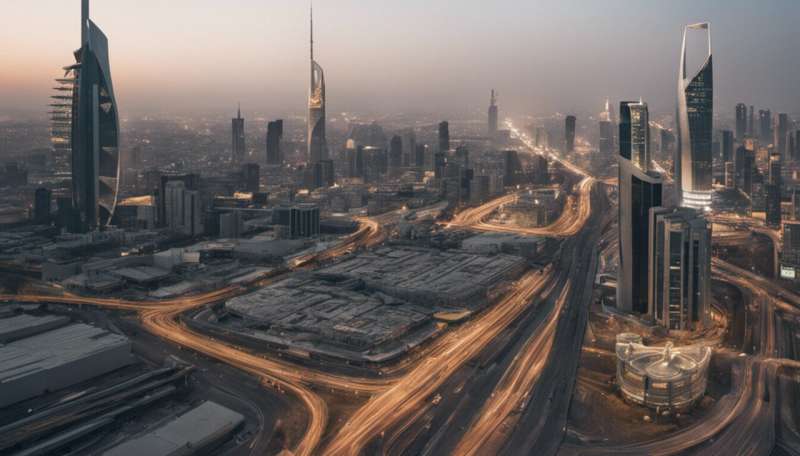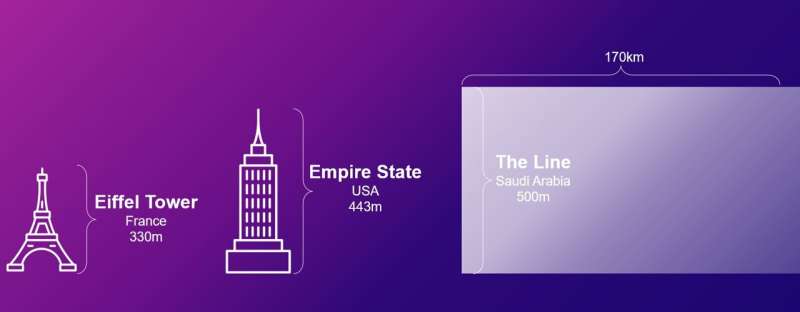This article has been reviewed according to Science X's editorial process and policies. Editors have highlighted the following attributes while ensuring the content's credibility:
fact-checked
trusted source
proofread
Saudi Arabia's 'The Line' isn't a revolution in urban living, say researchers

In October, the excavation work for the superlative construction project, "The Line," began. What some consider an ideal ecological city, others call a promotional gimmick. Researchers from the Complexity Science Hub now show why The Line should not be a showcase for future cities.
"It's the embodiment of the dream to start from scratch and completely rethink a city," says Rafael Prieto-Curiel, who researches cities at the Complexity Science Hub. The Line is planned to be a city built from nothing in the desert. It is to consist of two gigantic, unbroken rows of skyscrapers, with living space in between. It is planned to be 170 kilometers long, 200 meters wide and 500 meters high, higher than any building in Europe, Africa, and Latin America, stretching straight ahead from the Red Sea to the east.
Nine million people are expected to live in it—more than in any other city in Saudi Arabia. This translates into a population density of 265,000 people per square kilometer—ten times denser than Manhattan and four times denser than the inner districts of Manila, currently estimated to be the densest urban neighborhoods on Earth. "How you can attract that many people in a medium-sized country at all is yet to be observed," Prieto-Curiel points out.
Sixty minutes for a trip
Further questions arise in terms of mobility. "A line is the least efficient possible shape of a city," says Prieto-Curiel. "There's a reason why humanity has 50,000 cities, and all of them are somehow round," he emphasizes.
If we randomly pick two people in The Line, they are, on average 57 kilometers apart. In Johannesburg, which is 50 times larger in area, two random people are only 33 kilometers apart. Assuming a walking distance of one kilometer, only 1.2% of the population is within walking distance from each other. This hinders active mobility, so people will depend on public transport.
The backbone of public transportation is planned to be a high-speed rail system. "For everyone to be within walking distance of a station, there must be at least 86 stations," explains CSH researcher Dániel Kondor. As a result, trains spend considerable time in stations and will not be able to reach high travel speeds between any two stations.
According to the researchers, a trip, therefore, is expected to take 60 minutes on average, and at least 47% of the population would have an even longer commute. Even with additional express lines, gains are limited due to the additional transfers necessary. The result is that people would still be traveling longer than in other major cities, such as Seoul, where 25 million people commute for less than 50 minutes.

Research shows that people want to spend a limited amount of time commuting, so efficient transportation plays a key role in the success of cities. But can these trips through the city be avoided because high density allows everything (jobs, shopping, amenities, etc.) to be available locally?
"Cities are more than a collection of semi-isolated 15-minute neighborhoods located next to each other. What sets a city apart from smaller settlements is not just its size but additional opportunities outside the immediate neighborhood—such as concerts or an extended job search. For this reason, we need to consider citywide transportation," explains Kondor.
Why not 'The Circle'?
If you take "The Line" and make it "The Circle" with a radius of 3.3 kilometers, the distance between any two people would be only 2.9 kilometers, and 24% of the population would be within walking distance of each other. Most mobility could be active (walking, cycling, or similar), making a high-speed rail system unnecessary. Alternatively, The Circle could allow good connectivity even with lower densities, avoiding the need for supertall buildings.
"This project gets people discussing urban forms, and that's immensely important because cities, especially in Africa, are growing," says Prieto-Curiel. Historically, cities often grew in organic ways, while planned cities often did not live up to expectations; thus, there is a need for more public engagement about urban design on a human scale.
Additionally, sustainability is emphasized in many aspects of the project. For example, there will be no cars for distances that are no more than a five-minute walk. This not only saves a lot of space in terms of infrastructure and parking but also reduces the number of cars. Moreover, all energy will be produced with zero carbon emissions. What is not taken into account here, however, is the construction of the skyscrapers, which requires a lot of material and energy.
"Overall, it stands to reason that other considerations may have played a role in choosing this unique form, such as branding or creating engaging social media videos. However, it is important to understand the consequences, especially if The Line is treated as a showcase for modern building and urban planning technologies," emphasizes Prieto-Curiel.
The paper, "Arguments for building The Circle and not The Line in Saudi Arabia," has been published in the journal npj Urban Sustainability.
More information: Rafael Prieto-Curiel et al, Arguments for building The Circle and not The Line in Saudi Arabia, npj Urban Sustainability (2023). DOI: 10.1038/s42949-023-00115-y
Provided by Complexity Science Hub Vienna





















